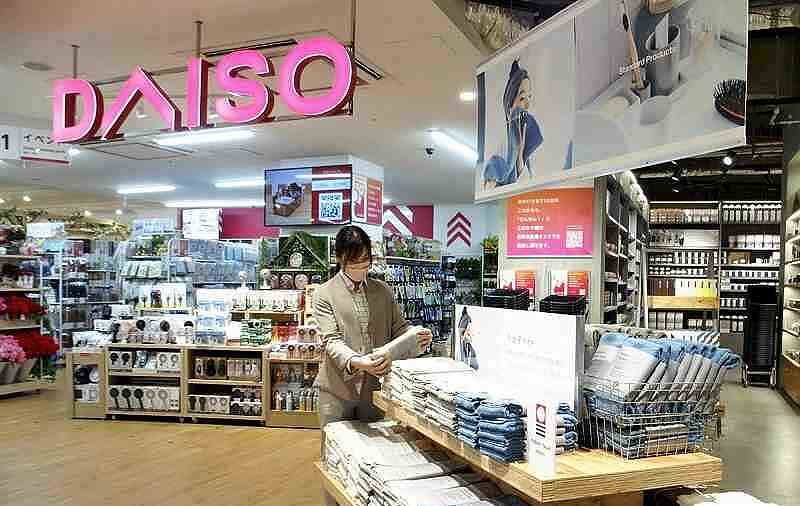
Daiso Industries Co.’s 100-yen Daiso brand, left, is set up next to its 300-yen brand shops on the same floor in the Ginza district of Tokyo.
21:21 JST, May 22, 2022
Rising costs of raw materials have gradually driven up the prices of daily goods, giving consumers in Japan used to deflation an ever heavier burden.
“There has never been such extreme increases in the prices of products in such a short period,” said an official at Kobe-based Motobayashi Co., which deals with the planning and wholesaling of about 1,500 kinds of sundry goods, including kitchen items.
It is difficult for the firm to lower the delivered prices of the merchandise because its main business clients are operators of 100-yen chain stores, considered a product of deflation.
Motobayashi has been taking pains in dealing with the current situation, such as by having the number of trash bags contained in a pack reduced from 20 to 15, or making the size of a plastic product smaller, while keeping the prices unchanged.
A manufacturer of plastic products is also working hard to negotiate prices with 100-yen shop. An official in charge of sales said, “At the current delivered prices, we cannot make up for the increases in the cost of products, making it impossible for us to manufacture our goods.”
The operators of 100-yen chains have been putting great emphasis on goods in a price range above ¥100, while striving to maintain the prices of their 100-yen brand products.
Daiso Industries Co., which operates the 100-yen chain Daiso, has also been offering a new brand called Threeppy, where items are sold at around ¥300.
Can Do Co., another operator of 100-yen chains, has also begun selling items priced over ¥100, which now account for about 10% of all its products.
“It is only from now on that the impact of the weak yen will really push up the prices of imported raw materials,” said Daisuke Iijima, a chief researcher at Teikoku Databank, Ltd. “There will be an increase in the number of those items priced higher than ¥100” at these 100-yen shops.
Blow to low wage earners
The Bank of Japan has advocated realizing a 2% inflation target in its large-scale monetary easing policy, which it has taken since 2013. The central bank had assumed a virtuous business cycle in which prices would rise continuously amid a business upturn, with domestic consumption galvanized thanks to wage hikes and the expansion of the workforce.
Although April’s 2.1% rise in the core consumer price index, which excludes fresh food, has numerically reached the target, the inflation has been due to soaring prices of natural resources, which have been exerting pressure on households, while wage hikes remain sluggish. Therefore, there is a gap between the reality of the numbers and what the central bank envisages as its blueprint.
“The soaring energy prices and the ensuing increase in shipping costs have been primary factors in the current inflation,” said Shinichiro Kobayashi, a senior researcher at Mitsubishi UFJ Research and Consulting Co. “Even from now on, price increases will continue, thus likely to depress consumption.”
Price increases have spread widely to food items. Mizuho Research & Technologies, Ltd. estimates that rising energy and food prices could increase the average household burden by about ¥60,000 per household this year.
“The most frequently purchased commodities like gasoline and groceries are the main items that have gone up in price,” said Saisuke Sakai, a senior economist at the Mizuho research institute. “This will deal a heavy blow to people at low incomes in particular.”
"Business" POPULAR ARTICLE
-

Tokyo Economic Security Forum to Hold Inaugural Meeting Amid Tense Global Environment
-

Keidanren Chairman Yoshinobu Tsutsui Visits Kashiwazaki-Kariwa Nuclear Power Plant; Inspects New Emergency Safety System
-

Imports of Rare Earths from China Facing Delays, May Be Caused by Deterioration of Japan-China Relations
-

University of Tokyo Professor Discusses Japanese Economic Security in Interview Ahead of Forum
-

Japan Pulls out of Vietnam Nuclear Project, Complicating Hanoi’s Power Plans
JN ACCESS RANKING
-

Tokyo Economic Security Forum to Hold Inaugural Meeting Amid Tense Global Environment
-

Keidanren Chairman Yoshinobu Tsutsui Visits Kashiwazaki-Kariwa Nuclear Power Plant; Inspects New Emergency Safety System
-

Imports of Rare Earths from China Facing Delays, May Be Caused by Deterioration of Japan-China Relations
-

University of Tokyo Professor Discusses Japanese Economic Security in Interview Ahead of Forum
-

Japan Pulls out of Vietnam Nuclear Project, Complicating Hanoi’s Power Plans

























